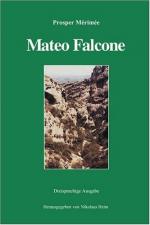|
This section contains 577 words (approx. 2 pages at 400 words per page) |

|
Romanticism and Realism
"Mateo Falcone" (1829) illustrates the cruel toll exacted on a Corsican family by the code of vendetta, or feud. Falcone kills his own son, Fortunato, because the son has betrayed a man to the authorities. Two concerns govern Merimee's style in "Mateo Falcone." The first is geographical and ethnological verisimilitude; the second is narrative minimalism, so that, for most of the story, Merimee's style can be described as spare and laconic.
It is useful to know that before he wrote the sequence of short stories that make up the collection Mosaic, in which "Mateo Falcone" appears, Merimee had written two literary hoaxes, the second of which, La Guzla (1827), exploits stylistic conventions associated with romanticism. Briefly, La Guzla (the word refers to the national instrument of the Albanian "bards," or poets) pretends to be a translation of native ballads of the mountagnards of "Illyria" (Albania), collected and translated...
|
This section contains 577 words (approx. 2 pages at 400 words per page) |

|




